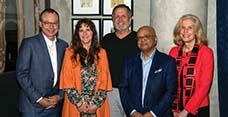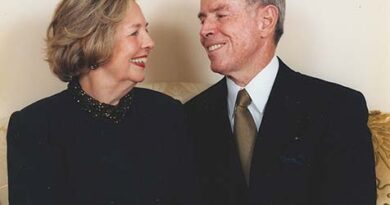Mysteries Unlocked
Published on July 6th, 2023 by Nancy Humphrey.
Before Blake Kirby was born 10 years ago, his mom, Kara Davis, knew from ultrasounds that he was very small and had clubfoot, an abnormality in which one or both feet are twisted out of shape or position.
“Other than that, we thought he was going to be OK,” she said.
When Blake stopped growing altogether, Davis was induced on March 16, 2013, at 36 weeks gestation. His heart rate dropped during labor, and when he was delivered at 4 pounds, 15 ounces, he was taken to the neonatal intensive care unit for observation. Physicians were also concerned about his appearance, and he failed a newborn hearing screening.
For the Mt. Juliet, Tennessee, family it was the beginning of a four-year diagnostic odyssey that at one point involved 16 specialists at Monroe Carell Jr. Children’s Hospital at Vanderbilt. It culminated in August 2017 with a diagnosis from the Vanderbilt arm of the National Institutes of Health’s Undiagnosed Diseases Network (UDN), which brings together clinical and research experts from across Vanderbilt to help solve medical mysteries for patients with complicated conditions and diseases.
VUMC is an original member of the NIH’s UDN, established in 2014. In 2021, the Vanderbilt Undiagnosed Diseases Program was launched to operate alongside the UDN to expand services to many more patients living with the consequences of an undiagnosed disease.
Blake is one of only 23 known people in the world to have Saul-Wilson syndrome, a very rare disorder first identified in 1990.
The disorder is characterized by skeletal abnormalities, short stature (dwarfism) and growth abnormalities that begin in the womb and continue after birth. The average adult with Saul-Wilson is 3 feet, 6 inches tall.
People with the condition usually have smaller than normal heads — known as microcephaly — and sometimes larger than normal heads — macrocephaly, a pronounced forehead and eyes that appear larger due to shallow eye sockets. The disease can also cause clubfoot, cataracts in the eyes, loss of night and peripheral vision, low levels of white blood cells (neutropenia), heart issues, delayed early speech and motor skills and hearing loss.
Four patients with Saul-Wilson syndrome were reported between 1982 and 1994, but the mutation that causes it wasn’t discovered until Blake’s diagnosis. Now, of the 23, the oldest is 30 and the youngest is 1. There is no known treatment for the disorder.
“I know finding out a name (of the syndrome) doesn’t change the outcome. There’s still no treatment. But just knowing the name meant the world. Before, everything was unknown,” Davis said.
Leaders in cutting-edge genetics
While most children are born healthy, about 6% are born with genetic and metabolic disorders. Figuring out how those defects originated and what medical treatments might help can sometimes be a complicated and emotional process for families — a mystery that needs to be unlocked.
The Division of Medical Genetics and Genomic Medicine within the Department of Pediatrics at Monroe Carell helps diagnose, counsel and treat patients with a wide range of genetic disorders, birth defects and developmental concerns. The team also can help families determine if their children’s conditions are hereditary and offer genetic testing to family members who may be at risk for having children with similar problems.
Genes contain the biologic instructions for life — DNA. They make us who we are and contribute to aspects of our health. Everyone has a unique genetic code, and sometimes changes in genes can result in birth defects or disabilities that require lifelong medical care.
The growing division at Monroe Carell has some of the most highly trained geneticists in the country. They’re a local, state and national leader in providing cutting-edge genetics services to patients.
The division leads Vanderbilt University Medical Center and Monroe Carell in the integration of genetics and genomics into medicine and health care with the single goal of improving patients’ lives. (Your complete set of DNA is called your genome.)
“Thanks to new genomic approaches, we are now in a position to make remarkable new insights into human health and encounter new opportunities for prevention, diagnosis and treatment of both common and rare conditions,” said Rizwan Hamid, MD, PhD, Dorothy O. Wells Professor of Pediatrics and director of the division since 2018.
Recently, a transformative gift from the Potocsnak family established the Potocsnak Center for Undiagnosed and Rare Disorders at VUMC. Hamid is the new center’s director, serving children and adults in a collaborative effort that crosses many disciplines.
The center will allow VUMC to accelerate research and serve more patients looking for answers and cures for diseases that, in some cases, have been undiagnosed for decades. There are an estimated 30 million people in the United States with rare diseases, many of whom do not have a diagnosis.
The Potocsnak Center for Undiagnosed and Rare Disorders makes a significantly larger impact possible for patients everywhere well into the future through the development of a robust program emphasizing collaboration, patient-centered care, innovation and training.
Over the years, John Potocsnak, through the Potocsnak Family Foundation, has supported countless nonprofit initiatives. The family’s involvement with VUMC, from philanthropy to advocacy, is led by a commitment to others and their own patient experience. In addition, John’s daughter, Liz Potocsnak, is a longtime member and now chair of the Vanderbilt Eye Institute Advisory Board.
“We wanted to do something for people who may otherwise be forgotten, and it was clear that VUMC has both the passion and ability to do so,” said Liz Potocsnak. “It’s our privilege to be part of the solution as the center furthers this wholehearted investment for as many patients as possible both in Tennessee and across the world through information sharing.”
The center will use a multipronged approach to grow the current undiagnosed diseases program. Plans include expanding the team dedicated to this cause, increasing the capacity for clinical analysis of genomic data, introducing new higher-resolution genome decoding technologies, and working to improve patient access.
“It’s an amazing gift that has the potential to help a group of patients with rare and undiagnosed disorders who have no other recourse or no other source for help,” Hamid said. “These undiagnosed patients don’t have a champion because they don’t have a diagnosis, but they can come to Vanderbilt and get help. The generosity of this family, and their decision to use their philanthropy to help this group of patients, is unparalleled and so very appreciated.”
Growing to serve more children
Over the past seven years, patient visits within the Division of Medical Genetics and Genomic Medicine have increased from 2,900 a year to more than 5,000, Hamid said. In 2018 there were three physician providers; now there are seven. Genetic counselors have increased from four to seven; nurse practitioners, from four to six.
“Clinically we have grown, and we are seeing significantly more patients both in the outpatient and inpatient setting,” Hamid said, adding that the division provides clinical care to patients throughout Tennessee, and into western North and South Carolina, all of Alabama, northern Georgia, all of Mississippi, northern Louisiana, and southern Indiana, Illinois and Missouri.
Regionally, the division has expanded its outreach, seeing patients where they work and live in Murfreesboro, Cookeville, Hendersonville and Clarksville. In addition, the division helps manage patients with genetic conditions at Niswonger Children’s Hospital in Johnson City, Tennessee.
The division also helps patients with unique needs and specific diagnoses.
Angela Grochowsky, MD, a provider within the division who treats both pediatric and adult patients, is working to expand Monroe Carell’s Down Syndrome Clinic for patients older than 18.
“Dr. Grochowsky’s interest in helping patients with Down syndrome transition from childhood to adulthood is fantastic,” Hamid said. “These families now have a geneticist who understands the nuances of young adults with Down syndrome.”
The division also has a collaboration with the state of Tennessee’s newborn screening program.
All babies born in Tennessee have a heel prick with about two to three drops of blood taken on day two of life to test for 67 rare genetic disorders that have treatment options. If tests are abnormal, the division is notified, the baby can be brought to Monroe Carell for tests confirming the condition, and early treatment, if warranted, can begin. Monroe Carell has established clinics for children with genetic disorders that are found on newborn screening, including adrenoleukodystrophy, Fabry disease, Krabbe disease and others.
Additionally, the division has a strong research focus. Joy Cogan, PhD, leads a project of gene discovery in idiopathic pulmonary fibrosis, a lethal lung disorder. Hamid, in collaboration with Eric Austin, MD, is working to discover genes responsible for pediatric pulmonary hypertension. John Phillips, MD, has a large translational research program in finding treatments for rare genetic disorders.
And providers within the division are actively involved in teaching as well. The division is responsible for teaching genetics to the next generation of medical students, genetics counselors and nurse practitioners.
“There aren’t enough genetics and genomics providers out there. We’re a small division of about 30 folks altogether, but you can see how much we do. Our reach is vast,” Hamid said.
Diagnostic Journey
Several months after he was born, Blake Kirby wasn’t meeting developmental milestones. He was seeing 16 specialists at Monroe Carell, including a geneticist.
“All these different doctors were looking into what they could figure out and were treating the symptoms. We were going to Monroe Carell every week and visited doctors on almost every floor of the Doctors’ Office Tower. We practically lived at Vanderbilt,” Davis said.
His geneticist recommended whole exome sequencing, but their insurance wouldn’t pay for the expensive testing. That’s when the family was recommended to Vanderbilt’s UDN, which took on his case.
After the team performed whole exome sequencing with a blood sample from Blake, a type of genetic sequencing to find out what is causing symptoms or a disease, they had a strong suspicion that they had an answer.

They worked collaboratively with the NIH and the Pacific Northwest UDN site to find more clues and confirm the diagnosis and found that Blake had a mutation in the COG4 gene, one piece of a group of proteins known as the conserved oligomeric Golgi (COG) complex. Since he was the first patient diagnosed with this mutation, a detailed search by several other collaborative teams (some from outside the U.S.) found more undiagnosed or misdiagnosed patients with many of the same symptoms. VUMC’s team was critical in solving this mystery due to some unique capabilities only available at Vanderbilt.
The families are now linked through a Facebook group, and now that the underlying cause of the condition is known, researchers are working to better understand the mechanisms of the disease, in hopes that a treatment will someday become available. The Facebook group is run by the two oldest patients with Saul-Wilson.
Davis, who has four other children, ages 31, 26, 13 and 12, said connecting with the group of patients and families through Facebook has been invaluable, allowing individuals with the disease and their families to share successes and hurdles.
“Since we’ve been able to put a name to it, we have been able to research as much as we possibly can. Knowing other people who have this and being able to ask, ‘We went to the doctor and found this out. Does it affect you?’ and ‘What have you gone through?’ has brought this community together and made a family of all of us,” she said.
“It seems like everyone’s experience has been that they didn’t know their baby was going to live. We’ve all had those doctors who have said, ‘Your baby probably isn’t going to make it.’ We’ve all walked through that. Then, as they get older, they stabilize and kind of catch up with milestones.”
Because of parents they have connected with, they knew that Blake would need cataract surgery. And they know that a hip replacement may be in his future.
Davis has been able to share Blake’s success taking growth hormone after several of the patients in the group were told that taking growth hormone doesn’t work.
“I’ve been able to show them Blake’s medical records and show that although it’s working slowly, it’s working,” Davis said. “The majority of us in the group are parents of children with Saul-Wilson. We’ve been able to come together and talk about our experiences and our struggles. We’re bonded because of that group. We’ve become a real family.”
Although he struggled to meet early milestones, Davis said Blake is “thriving” and in third grade, which he attends virtually. He is reading at a fourth-grade level and his math skills were at a third/fourth-grade level last year.
“Having a diagnosis doesn’t change who Blake is. He’s still the funny little firecracker who loves to tell jokes, who is determined and who doesn’t let anything slow him down. He finds ways to adapt if he’s having any difficulty. He may be small, but he’ll find a way,” she said.
“But having a diagnosis has given us a community that understands and helps us prepare for the road ahead. It’s also given us hope. Before, we didn’t know if there would be a future for Blake, but now we know he has a huge, bright future ahead of him, and he is capable of doing anything he sets his mind to. He’s already defied what so many doctors thought he would ever be able to do.”




